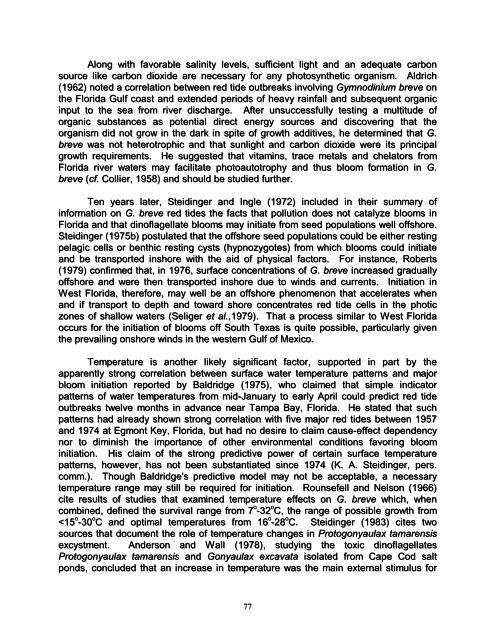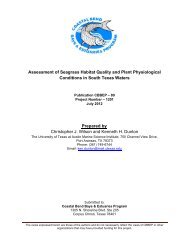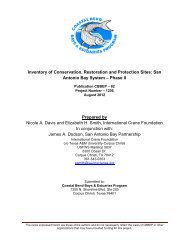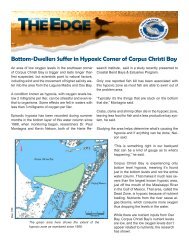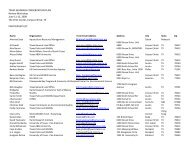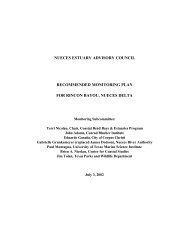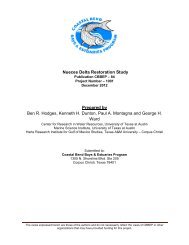Current Status and Historical Trends of Brown Tide and Red Tide ...
Current Status and Historical Trends of Brown Tide and Red Tide ...
Current Status and Historical Trends of Brown Tide and Red Tide ...
- No tags were found...
You also want an ePaper? Increase the reach of your titles
YUMPU automatically turns print PDFs into web optimized ePapers that Google loves.
Along with favorable salinity levels, sufficient light <strong>and</strong> an adequate carbonsource like carbon dioxide are necessary for any photosynthetic organism. Aldrich(1962) noted a correlation between red tide outbreaks involving Gymnodinium breve onthe Florida Gulf coast <strong>and</strong> extended periods <strong>of</strong> heavy rainfall <strong>and</strong> subsequent organicinput to the sea from river discharge. After unsuccessfully testing a multitude <strong>of</strong>organic substances as potential direct energy sources <strong>and</strong> discovering that theorganism did not grow in the dark in spite <strong>of</strong> growth additives, he determined that G.breve was not heterotrophic <strong>and</strong> that sunlight <strong>and</strong> carbon dioxide were its principalgrowth requirements. He suggested that vitamins, trace metals <strong>and</strong> chelators fromFlorida river waters may facilitate photoautotrophy <strong>and</strong> thus bloom formation in G.breve (cf. Collier, 1958) <strong>and</strong> should be studied further.Ten years later, Steidinger <strong>and</strong> Ingle (1972) included in their summary <strong>of</strong>information on G. breve red tides the facts that pollution does not catalyze blooms inFlorida <strong>and</strong> that din<strong>of</strong>lagellate blooms may initiate from seed populations well <strong>of</strong>fshore.Steidinger (1975b) postulated that the <strong>of</strong>fshore seed populations could be either restingpelagic cells or benthic resting cysts (hypnozygotes) from which blooms could initiate<strong>and</strong> be transported inshore with the aid <strong>of</strong> physical factors. For instance, Roberts(1979) confirmed that, in 1976, surface concentrations <strong>of</strong> G. breve increased gradually<strong>of</strong>fshore <strong>and</strong> were then transported inshore due to winds <strong>and</strong> currents. Initiation inWest Florida, therefore, may well be an <strong>of</strong>fshore phenomenon that accelerates when<strong>and</strong> if transport to depth <strong>and</strong> toward shore concentrates red tide cells in the photiczones <strong>of</strong> shallow waters (Seliger et al.,1979). That a process similar to West Floridaoccurs for the initiation <strong>of</strong> blooms <strong>of</strong>f South Texas is quite possible, particularly giventhe prevailing onshore winds in the western Gulf <strong>of</strong> Mexico.Temperature is another likely significant factor, supported in part by theapparently strong correlation between surface water temperature patterns <strong>and</strong> majorbloom initiation reported by Baldridge (1975), who claimed that simple indicatorpatterns <strong>of</strong> water temperatures from mid-January to early April could predict red tideoutbreaks twelve months in advance near Tampa Bay, Florida. He stated that suchpatterns had already shown strong correlation with five major red tides between 1957<strong>and</strong> 1974 at Egmont Key, Florida, but had no desire to claim cause-effect dependencynor to diminish the importance <strong>of</strong> other environmental conditions favoring bloominitiation. His claim <strong>of</strong> the strong predictive power <strong>of</strong> certain surface temperaturepatterns, however, has not been substantiated since 1974 (K. A. Steidinger, pers.comm.). Though Baldridge's predictive model may not be acceptable, a necessarytemperature range may still be required for initiation. Rounsefell <strong>and</strong> Nelson (1966)cite results <strong>of</strong> studies that examined temperature effects on G. breve which, whencombined, defined the survival range from 7 o -32 o C, the range <strong>of</strong> possible growth from


